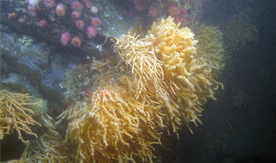
Rhian Waller to Examine As-of-yet-unexplored Remote Fjords in Glacier Bay National Park and Preserve
When planning a trip, travelers often consider their destinations’ peak tourist seasons and weather.
Rhian Waller schedules her voyages around whale migration, glacial melting and ocean clarity.
This spring, the associate research professor in the University of Maine School of Marine Sciences will be chief scientist on an expedition to explore, map and survey underwater habitats and ecosystems of Glacier Bay National Park and Preserve (GBNP) in Alaska.
Waller has been awarded $897,504 for the collaborative project with the U.S. National Park Service, National Oceanic and Atmospheric Administration (NOAA), U.S. Geological Survey (USGS), University of Connecticut (UConn), University of Hawaii and Rutgers University.
Waller, a Fellow in the international Explorers Club that encourages scientific discovery while exploring land, sea and space, will examine deep ecosystems in some of the as-of-yet-unexplored remote fjords facing the outer Gulf of Alaska within the GBNP park boundaries.
The park’s unique fjord region has complex geological formations that provide a diverse array of marine habitats, says Waller. And what the divers and ROV learn will inform the National Park Service’s marine resource management decisions.
Cold-water corals are ecosystem engineers — they form important habitats and create sanctuaries to support diverse wildlife, she says. Cold-water corals were discovered in the park at scuba-diving depths just a few years ago, but Waller says the biology at the bottom of the deep fjords is virtually unknown.
GBNP’s fjords have been protected since 1925 when the park was created. In 1999, Congress mandated commercial fisheries closures, thereby creating a network of protected areas within the 3.3 million-acre park.
“What is exciting about this research is the potential to find ‘unharmed’ cold-water corals. Almost everywhere we go we see some human influence on the cold-water coral ecosystems we discover, yet here the communities have had 90 years of protection,” Waller says.
“The other exciting part is the applicability to the National Park Service, and its mission of educating the public about the world around us. I’m really looking forward to this large collaboration.”
The researchers will utilize a remotely operated vehicle (ROV) and will scuba dive to collect data and samples.
Waller has pressed the limits of diving during more than 40 expeditions around the planet. In a submersible, she once plunged to a depth of 3,600 meters for corals on the New England Seamount chain in 2005.
She frequently scuba dives in temperatures of 35 degrees Fahrenheit and below in the name of science. The celebrated ice water diver was featured in National Geographic Magazine in 2013 as a 21st-century risk taker in the “New Age of Exploration.” So diving in Alaska in March shouldn’t be a problem.
This past summer, she took part in an illuminating 15-day, 21-dive deep-sea coral cruise in the Gulf of Maine aboard the 76-foot research vessel Connecticut.
The $413,562 research project was a collaboration between UMaine, UConn and NOAA. Researchers used the ROV Kraken 2 to explore the Jordan Basin, Schoodic Ridges, northern Stellwagen Bank National Marine Sanctuary and western Wilkinson Basin.
In the Schoodic Ridges region, scientists were thrilled and amazed to see 40-foot-tall, dense hanging gardens of Primnoa coral at a depth of 656 feet.
“The coral gardens were spectacular,” Waller says. “We knew corals were in these areas from a cruise last year, but to see them in such high densities, covering 30-foot-high walls, was an unexpected and thrilling find.”
During the dive, the researchers collected 134 samples of corals as well as sponges, fishes and other marine life for analysis.
The Schoodic Ridges coral ecosystem, Waller says, likely attracts pollock and herring, which then attract larger prey fish.
For about a century, Waller says fishermen have captured corals along with fish in their gear in the Gulf of Maine. This research, she says, illustrates how much more there is to learn about the ecosystem, which can lead to better conservation and management of its natural resources.
For two years, Waller and UMaine graduate student Steven Auscavitch have worked in the Gulf of Maine as part of a larger deep-sea coral research program funded by NOAA’s Deep-Sea Coral Research and Technology Program.
Contact: Beth Staples: 207.581.3777
